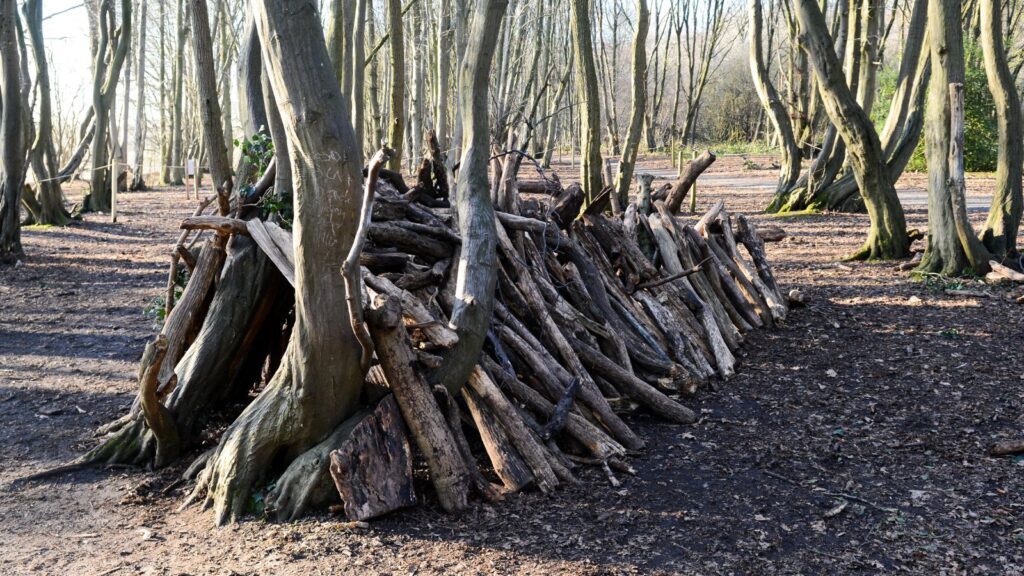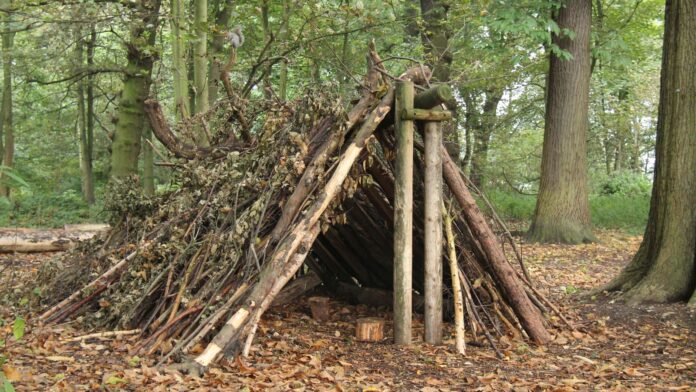Venturing into the great outdoors can be an exhilarating experience, but it’s crucial to be prepared for any unexpected challenges that Mother Nature may throw your way. One essential skill every adventurer should possess is the ability to build an emergency shelter for survival in the wilderness.
In this ultimate guide on emergency shelter building, we’ll provide you with all the necessary information and techniques needed to construct effective and secure shelters that could potentially save your life.
Key Takeaways
- Building an emergency shelter is critical for survival in the wilderness as it provides protection from the elements, increases chances of survival, reduces exposure to wildlife, maintains body heat, and promotes a sense of security.
- Choosing the right location for your emergency shelter is crucial. Look for areas with adequate natural resources such as firewood and water while avoiding hazardous zones like floodplains or animal dens.
- There are various types of emergency shelters you can build including debris shelters, tarp shelters, snow shelters, lean-to structures and bivvy bag shelters. Each type has its advantages depending on your needs and environmental conditions.
- Insulating materials such as leaves or pine branches help trap warm air inside your constructed shelter preventing hypothermia or frostbite. Additionally having extra layers of clothing helps retain warmth while camping out in night time temperatures that drop suddenly throughout various seasons.
Why Emergency Shelter Building Is Critical For Survival
Building an emergency shelter is critical for survival as it provides protection from the elements, increases survival chances, reduces exposure to wildlife, maintains body heat, and provides a sense of security.
Protection From The Elements
One of the most crucial aspects of building an emergency shelter in the wilderness is ensuring that it provides adequate protection from the elements. Exposure to harsh weather conditions such as extreme heat, cold, wind, rain, or snow can lead to hypothermia, frostbite, dehydration and other life-threatening situations if not addressed properly.
For instance, let’s consider two hikers who were caught in an unexpected snowstorm during their off-grid adventure. While one hiker managed to quickly construct a proper snow shelter using available resources like branches and compacted snow blocks for insulation from freezing temperatures and windchill outside his walls; the other failed to create an effective haven and eventually succumbed to hypothermia due to prolonged exposure.
Increased Survival Chances
Building an emergency shelter in the wilderness can greatly increase your chances of survival. It provides protection from harsh weather conditions such as rain, snow, and wind, which can cause hypothermia and other life-threatening illnesses.
In addition to keeping you warm and dry, a shelter also reduces your exposure to wildlife that may be dangerous or carry diseases. By providing a sense of security, it helps to reduce stress levels and promote mental health during stressful situations.
With an emergency shelter built correctly in the right location using essential items like debris shelters or tarp shelters are very effective ways for off-grid living individuals to survive unexpected situations in the wild.
Reduced Exposure To Wildlife
When building an emergency shelter in the wilderness, reducing exposure to wildlife is crucial. With a well-built shelter, you can minimize contact with dangerous animals and prevent them from attacking or damaging your temporary home.
Most emergency shelters are made using natural materials found in the surrounding environment, making it possible for animals to smell and track you down.
Some simple tips include avoiding locations near water sources as they attract animals looking for a drink or hunting ground; keeping any food stored or hung up high out of sight; and sealing off any openings in your shelter that may allow pests inside.
Maintaining Body Heat
One of the most critical aspects of building an emergency shelter is maintaining body heat. The wilderness can be a brutal place, especially for those not adequately prepared.
Without proper protection from the elements, hypothermia, frostbite, and other cold-related illnesses can set in quickly.
Additionally, you should always carry extra clothing layers with you to wear while sleeping – even if it doesn’t seem necessary initially. It’s better to have too much insulation than not enough! As temperatures drop at night, make sure you add more blankets or a thicker sleeping bag as needed and avoid sweating by wearing breathable clothes that draw moisture away from your skin.
Providing A Sense Of Security
Building an emergency shelter in the wilderness not only provides protection from the elements, but it also offers a sense of security. Knowing that you have a safe haven to retreat to during unexpected situations can reduce stress and increase your chances of survival.
In addition, having a designated space for sleeping and storing supplies can help you feel more organized and prepared.
An effective way to enhance feelings of safety is by adding some personal touches to your shelter. This could include hanging up family photos or bringing along items with sentimental value.
These small details can go a long way towards making you feel more at home in your wilderness surroundings.
Choosing The Right Location For Your Emergency Shelter
Choose a location that provides adequate natural resources, is protected from wind and rain, and avoids hazardous areas such as floodplains, avalanche zones or near animal dens.
Adequate Natural Resources
Choosing the right location for your emergency shelter is crucial when it comes to finding natural resources. You should look for areas where you can easily gather firewood, water, and other necessary supplies.
Additionally, adequate shelter will depend on finding an area with trees or vegetation that can be used as cover against wind and rain. Once you have identified the ideal spot for your shelter, you can start gathering materials such as tree branches or debris to use in building a strong framework.
Protection From Wind And Rain
Building an emergency shelter in the wilderness is crucial for protection from wind and rain. In a survival situation, exposure to the elements can quickly lead to hypothermia or other health complications.
When selecting a location for your shelter, make sure it is shielded from strong winds and potential flood zones. Constructing a lean-to or debris hut with proper insulation can be effective in protecting against these weather conditions.
According to outdoor experts, understanding how to create effective wilderness survival shelters should be considered one of the most essential outdoor skills. The article features step-by-step instructions on building 11 different simple designs for survival shelters that are proven to withstand harsh climates including snowstorms and heavy rainfall.
Avoiding Hazardous Areas
When choosing a location for your emergency shelter, it’s important to avoid hazardous areas. This includes areas prone to flooding or landslides, as well as areas with dangerous wildlife.
Look for higher ground with good drainage and try to avoid building near animal dens or watering holes. Keep an eye out for poison ivy and other harmful plants that could cause skin irritations or worse if touched.
According to outdoor experts, picking the right spot is essential in increasing chances of survival during emergencies in the wilderness. Avoiding hazardous areas such as flood-prone regions and places at risk from natural disasters like landslides is crucial.
Also, staying clear of animal habitats will prevent unexpected encounters with potentially dangerous creatures like snakes or bears. When scouting locations for a shelter, check all vegetation around it thoroughly before settling on it; some plants can cause severe rashes or even death upon contact with bare skin.
Types Of Emergency Shelters
This section will cover the different types of emergency shelters, including debris, tarp, snow, lean-to, and bivvy bag shelters.
Debris Shelters
Debris shelters are among the simplest and most effective types of emergency shelters for survival in the wilderness. These shelters are constructed using natural materials such as branches, leaves, and debris to create a protective layer between you and the elements.
Debris shelters require minimal tools or equipment to build, making them an ideal option if you don’t have access to specialized gear. Popular designs include lean-to structures built against a tree trunk or rock face, A-frame designs that use sticks lashed together at the top, and wigwams constructed from leafy branches woven together at the base.
Tarp Shelters
Tarp shelters are one of the easiest and most versatile options for building an emergency shelter in the wilderness. All you need is a tarp, some rope or paracord, and a few sturdy natural objects like rocks or trees to create your shelter.
One advantage of tarp shelters is that they can be set up quickly with minimal effort. They also provide adequate protection from rain and wind while allowing good ventilation.
Moreover, tarps are lightweight and easy to carry on backpacking trips or camping expeditions.
Snow Shelters
Snow shelters are essential for survival in snowy conditions. They provide warmth, shelter from the wind and snow, and a sense of security.
To build an igloo, compacted snow blocks must be used to form a dome shape with an entrance tunnel. Quinzhees require a large pile of snow that has been allowed to settle before being carved into living space inside the mound.
These structures are well-suited for long-term survival in deep-snow locations but may not be as practical or efficient in areas without sufficient snowfall.
Lean-to Shelters
Another type of emergency shelter that may appeal to off-grid living enthusiasts is the lean-to shelter. This shelter design typically involves finding a sturdy tree or using a long branch as support for one end and leaning smaller branches against it to create a sloping roof.
One major advantage of building a lean-to shelter is that it requires minimal resources while still offering good protection from wind and rain. It’s also relatively easy to construct, making it an ideal choice for an unexpected overnight stay in the wilderness.
Bivvy Bag Shelters
Bivvy bag shelters are a great option for those looking to build an emergency shelter quickly and with minimal materials. These simple shelters consist of nothing more than a waterproof bag that can be easily packed and carried on outdoor adventures.
Using a bivvy bag shelter is straightforward – simply crawl inside, cinch it tight around your head, and settle in for the night. While they don’t offer much in terms of comfort or space, they do provide protection from wind, rain, and other elements that could threaten your safety.
Step-by-Step Guide To Building An Emergency Shelter
In this section, we will provide a detailed step-by-step guide on how to build an emergency shelter from scratch.
Essential Items For Building A Shelter
To build a sturdy shelter in the wilderness, you’ll need some essential items on hand. First and foremost, you’ll require a dependable tool that can help you cut or break branches to create your shelter’s framework.
Other must-have tools include ropes, cords, tarps or blankets for insulation and protection from the elements, and a knife that can be used for everything from stripping bark to cutting cordage.
You should also have access to natural resources such as leaves, fir boughs, grasses, mosses and other plant materials which can serve as ideal insulation against cold winds or frosty nights.
Remember to look for dead limbs that are still attached to living trees – these will provide excellent lumber for building walls of your structure without harming any live trees – while dry grass is perfect for making tinder bundles if you plan on starting campfires inside your shelter.
Finding A Suitable Location
Choosing the right location for your emergency shelter is crucial to your survival. Look for a dry and well-drained spot that offers protection from wind and rain. Avoid hazardous areas like steep slopes, flood-prone areas, or places with dead trees and branches that could fall on you.
It’s also helpful to choose a location that has adequate natural resources nearby such as water, food sources, and firewood.
In addition to finding a suitable location, it’s important to be prepared with essential items when building your shelter. Always bring along materials like paracord ropes or duct tape, knives or saws for cutting wood and cordage if you need them.
Gathering Materials
To build a sturdy emergency shelter, it’s crucial to gather the right materials. Look for resources that are readily available in the area where you plan to construct your shelter.
For example, if you’re in a forested region, look for branches and twigs that can be used for the framework of your structure.
If you’re near a water source, collecting long grasses or reeds can help provide additional insulation alongside other organic materials. In areas with rocky terrain, stacked stones can create a solid base on which to rest branches or logs.
By gathering these foundational elements before starting construction on your emergency shelter, you will save time and ensure greater success in building an effective survival haven.
Building The Framework
Building the framework of your emergency shelter is one of the most critical steps in constructing a sturdy and reliable structure. The first step is to find two strong trees or poles that will serve as support for your ridgepole, which should be taller than the height of your shelter.
You can then lay other poles across these supports to create an A-frame shape, which will form the basis of your shelter’s roof.
To ensure maximum protection from the elements, it is important to choose materials that are dense enough to withstand heavy winds and precipitation. Look for thick branches with multiple limbs that have not fallen victim to rot or decay.
If possible, avoid using deadwood or softwood trees such as pine or cedar as they tend to snap under pressure when wet.
Covering And Insulating The Shelter
Once you have built the framework, the next step is to cover and insulate your emergency shelter. Choosing the right materials can make a big difference in keeping you warm and dry.
For insulation, consider using natural materials such as leaves, grass, or moss packed between layers of tarp or debris.
To cover your shelter, use tarps, ponchos, garbage bags or any other waterproof material available. Be sure to secure them tightly around your shelter with rope or cordage tied in multiple points for stability.
Overall, covering and insulating the shelter are crucial steps towards staying safe during emergencies in the wilderness.
Creating A Smoke Hole
When building your emergency shelter, it’s crucial to consider the smoke hole. This is a small opening at the top of the shelter designed to allow smoke from a fire to escape and prevent carbon monoxide poisoning.
To create a smoke hole, you can simply leave an open space in the roof or build a chimney using branches or sticks. It’s essential always to place your fire away from any flammable materials, including your shelter’s walls or roof.
When constructing your shelter, keep in mind that some designs may require more extensive ventilation systems than others.
Essential Tips For Building And Maintaining An Effective Emergency Shelter

Make sure your shelter is built to last and keep you safe with these six essential tips. From choosing the right materials and prioritizing insulation to planning for emergencies, maintaining your shelter, staying safe inside it, and wilderness survival techniques – this section has got you covered.
Choosing The Right Materials
Choosing the right materials when building an emergency shelter is critical for a successful outcome. It’s important to use natural resources available in your surrounding area, such as sticks, leaves, and branches.
These materials can help provide insulation from the cold and protection from wind and rain.
It’s essential to prioritize materials that will keep you warm and dry while also being lightweight enough to carry with ease during an emergency situation. Your choice of material should depend on weather conditions where you plan to build your shelter.
Keeping these crucial factors in mind when selecting the right materials will increase your chances of surviving the harshest wilderness environments even with limited resources at hand.
Prioritizing Insulation
A critical aspect of building an emergency shelter is prioritizing insulation. In the wilderness, temperatures can drop quickly and significantly, putting your survival at risk if you don’t have adequate insulation.
To ensure proper insulation, consider using natural materials such as dry leaves, grasses, or branches layered up against the walls and covered with a waterproof layer like a tarp or plastic sheeting.
You may also want to use a sleeping bag or bivvy bag inside the shelter for added warmth.
Planning For Emergencies
In any emergency or survival situation, it’s important to plan ahead for potential challenges. This is especially true when building an emergency shelter in the wilderness.
To start, make sure you have essential items like a first aid kit, water filtration system, and fire-starting tools readily available. It’s also important to have a backup plan in case your primary shelter location becomes unsafe due to weather or other factors.
Additionally, think about how you will signal for help if necessary and practice basic wilderness navigation skills in advance so that you can find your way back to civilization if needed.
Maintaining Your Shelter
Once your emergency shelter is built, it’s important to maintain it properly, especially if you plan on staying there for an extended period. To make sure your shelter lasts, prioritize insulation and regularly check for any signs of damage or wear and tear that may need repair.
Keep in mind that unexpected weather shifts can cause issues like leaks or clogged ventilation holes, so be vigilant about keeping these areas clear and dry. Additionally, try to avoid cooking inside the shelter as smoke can lead to respiratory problems and potentially ignite the structure.
Staying Safe In Your Shelter
Staying safe within your emergency shelter is just as important as building it. After all, the purpose of any survival shelter is to protect you from the elements and keep you safe from harm.
One crucial tip for staying safe in your emergency shelter is choosing materials that are fire-resistant or non-flammable, especially if you plan on having a fire inside your shelter.
It’s also essential to be aware of hazards around and above your shelter such as falling branches or rocks. If possible, choose a location with no overhanging trees or cliffs nearby.
Lastly, keeping yourself clean and dry can go a long way towards preventing illness or infection while in the wilderness.
Final Tips For Wilderness Survival
As you build your emergency shelter in the wilderness, it is crucial to take note of some essential tips that will help you survive. Firstly, always prioritize staying warm and dry by using materials like leaves or grass to create an insulating layer inside your shelter.
Additionally, be mindful of the available resources in your environment as these can come in handy when constructing your shelter. Finally, it’s vital to have basic survival skills such as starting a fire and sourcing clean drinking water because these are critical for long-term survival in the wilderness.
Conclusion
In conclusion, knowing how to build an emergency shelter is a crucial skill for anyone venturing out into the wilderness. By following the step-by-step guide and essential tips outlined in this article, you can create a shelter that will protect you from harsh weather conditions and increase your chances of survival.
Remember to always prioritize safety, choose suitable materials, and maintain your shelter regularly. With these skills under your belt, you’ll be ready to face any unexpected situations during your adventures in the great outdoors.
FAQs:
1. What materials do I need to build an emergency shelter in the wilderness?
The materials needed can vary depending on the climate and environment you are in, but some common options include tree branches, leaves, moss, grasses or other natural resources that can create a sturdy barrier between you and the elements.
2. How long does it take to build an emergency shelter?
The time it takes to construct an emergency shelter depends on several factors such as your skill level, available tools and resources. It can range from a few hours to a day’s work.
3. What are some tips for building a sturdy shelter that can withstand harsh weather conditions?
Selecting proper building materials is crucial in constructing a durable and well-protected shelter against inclement weather conditions like heavy wind or rainfall. It’s recommended to have ample knowledge of different knotting techniques that will increase structural integrity while also reducing wear & tear over time.
4. Can I use my survival kit items to help with making my emergency shelter?
Most survival kits come equipped with specific materials intended for outdoor shelters- i.e., rope/cordage & tarps- so yes! If you have pre-packed essentials inside your kit then these will likely be useful when constructing temporary structures out in nature during emergencies where there may not be any nearby buildings or other safe havens around especially if staying out overnight without assistance from others nearby.




